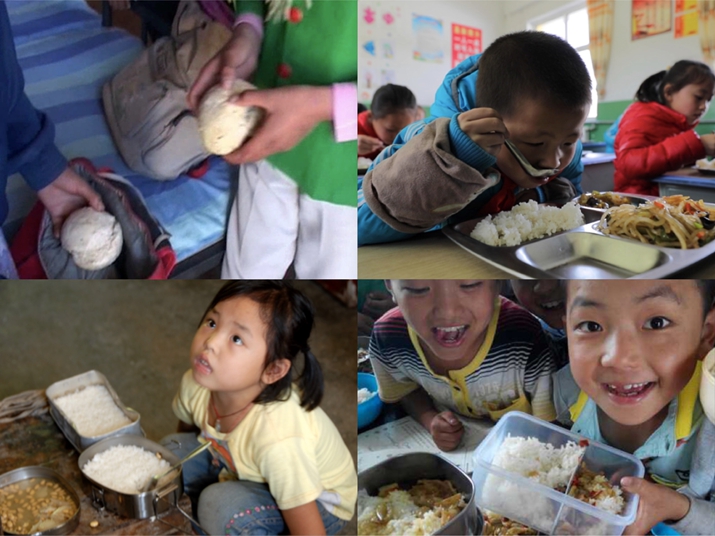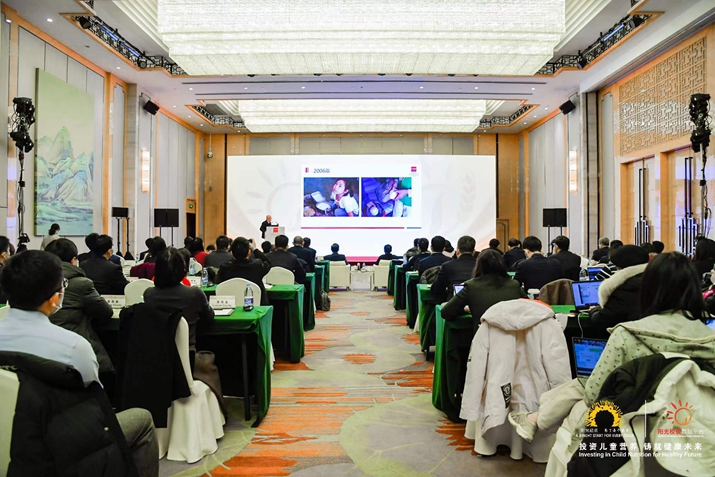| China |
| China's nutrition improvement plan benefits students | |
|
|
 Comparison between the rural student lunches in 2006 (left) and after 2012 (COURTESY PHOTO)
What does 3 to 5 yuan ($0.47-0.78) buy you in a Chinese metropolis? The answer: one small bottle of water or a cup of instant coffee. Across the vast rural area, however, this small sum can buy a student better health. Tie Jiaxin is a pupil at Daping Primary School in Xiji County, Ningxia Hui Autonomous Region. Every day, she enjoys a free school lunch package consisting of one meat and two vegetable dishes such as fried beef with green peppers and glass noodles, fried carrots with shredded potatoes or fried cabbage with garlic-stirred scallions and mushrooms. Xiji was removed from the country's poverty list in 2020. The village school used to be one of the county's most poorly funded ones and back in the day, students never knew what they would be eating—or when. Students had to prepare their own lunch and many would just grab some buns on their way out in the morning, according to Tie Yanbiao, father of the young girl. The school was first included in the Nutrition Improvement Program for Rural Compulsory Education Students in the spring semester of 2012, providing participants with free meals. The program intends to palpably slash malnutrition rates among rural students in poor areas during their nine years of compulsory education and promote educational equality. Starting in 2011 with 3 yuan for each student per day subsidized by the Central Government budget, this backing was later raised to 4 yuan in 2014, and then 5 yuan in the fall semester of 2021. By the end of 2020, the policy covered 1,732 counties in 28 provincial-level regions. It currently benefits approximately 37 million students each year. In 2021, the Central Government's allocation to the program was approximately 26 billion yuan ($4.08 billion), up 12.9 percent from the previous year. Despite the lingering impacts of COVID-19, China's rural student nutrition has continued its upward trajectory. "My daughter now enjoys a better balanced intake and can maintain a healthy diet," the father said in a documentary about the program. Acceptable to remarkable Measurements of nutrition, including height, weight and body mass index, are improving, according to Lu Mai, former Vice Chairman of China Development Research Foundation (CDRF), at an international symposium for the 10th anniversary of the nutrition improvement program in Beijing on December 18, 2021. About 15 years ago, Lu, also the initiator of the program, conducted a field survey on student nutrition in Guangxi Zhuang Autonomous Region, when he and the CDRF survey team found that some rural students were living on a diet of soybeans and rice. Today, this rather distressing situation has changed for the better, according to an evaluation report released at the symposium. The average difference in height between children aged 7 to 15 in less developed rural areas and the national average narrowed from 10 cm in 2012 to less than 3 cm in 2021, with the proportion of shorter children in less developed areas moving from 12.3 to 5.1 percent, according to the report. Brain function, too, is on the up, as demonstrated by the students' enhanced learning abilities and higher grades across the scoreboard, the report reads. Their newfound physical health in turn improves their families' understanding of nutrition, and lays the solid foundations for the development of future generations. The initiative benefits more than school children. Xian Ruifang, Deputy Mayor of Xiji, said in the documentary that the program provides a stable source of income for the agricultural product suppliers involved, as well as boosts employment for surplus rural labor. According to the report, the program could create about 290,000 canteen and related jobs across the countryside. The report suggests expanding the coverage of program to preschool education. According to He Xiuqian, an official with the Department of Education of Guizhou Province, since 2016, the local government has begun offering a 3-yuan subsidy for each preschool student per day, benefiting some 800,000 recipients. Many more provinces have put in place different supplementary plans in accordance with the national one. The newly introduced subsidies are spent specifically on food, with other costs such as canteen maintenance covered by local government budgets. In November 2021, 30 students in Fengqiu County, Henan Province, got food poisoning after eating their lunch prepared by a contract supplier. The company would cook the meals in one place and then transport them to the school. As the proof was quite literally in the pudding, this modus operandi can entail food safety risks. Lu added, "We shall reduce outsourcing, given most schools have the option to use their own canteen." The report also notes that if a school outsources its canteen business to an outside company, the average canteen worker salary will decrease from 1,500 yuan ($235) to 1,200 yuan ($188); the quality of food, too, will drop. Another two obstacles are obesity and excessive salt intake. In 2015, the CDRF set up an online platform for the program's real-time supervision and assessment. It evaluates the food's nutritional quality based on the daily information uploaded by the related school, pictures included. Another principal strategy is to tighten law-based oversight, continuously improving the initiative's efficacy and thereby ensuring every cent goes to feeding children in need. "In both high-quality economic development and the pursuit of common prosperity, children's growth should be a focal point. In the future, stronger initiatives must be issued to increase public investment in children's nutrition, health and education, and to improve their all-round development," Li Wei, Chairman of CDRF, said at the meeting.  An international symposium on China's Nutrition Improvement Plan takes place in Beijing on December 18, 2021 (COURTESY PHOTO)
Leading by example School-based food and nutrition intervention across underdeveloped regions have not only been a key component in China's poverty alleviation efforts, but have also served as a model for other school meal programs around the world, according to Valerie Guarnieri, Assistant Executive Director of the United Nations World Food Program (WFP). "In the last decade, China has made great achievements…We have learned a lot from China's experiences and successes," Guarnieri told the symposium via video link. The WFP and China share a long-standing cooperation. In early 2000, the WFP supported China to implement a school feeding program in Qinghai and Gansu provinces as part of the organization's integrated rural development intervention project. In 2009 and 2010, the Chinese Government started piloting the design of a national school feeding program. The WFP collaborated with China to provide input and guidance to the program's eventual introduction, according to Guarnieri. By now, "the scale and quality of Chinese school feeding programs serve as a great example for other countries," she said. This experience sharing is valuable in the context of South-South and triangular cooperation, especially in the areas of food safety, quality, innovation, digital monitoring and financial management. The prevalence of growth-stunting in Chinese children under the age of 5 today stands below the Asian average, Gerda Laiming, Assistant Secretary General of the United Nations and coordinator of the Scaling Up Nutrition Movement, said. She added that China's student nutrition improvement program and its efforts to improve child health are highly recommendable. (Print Edition Title: Nouvelle Canteen Cuisine) Copyedited by Elsbeth van Paridon Comments to taoxing@cicgamericas.com |
|
||||||||||||||||||||||||||||
|